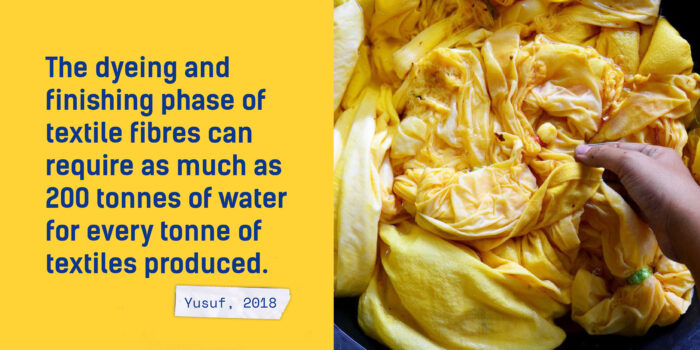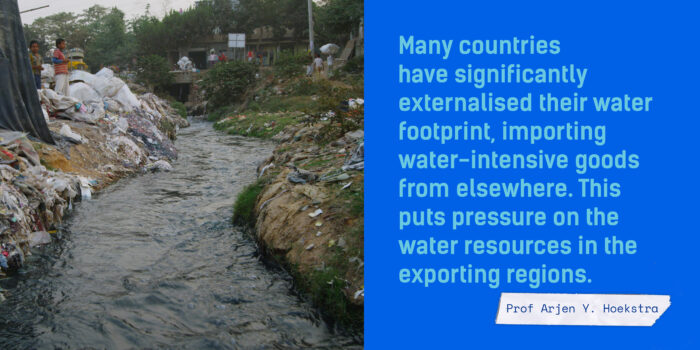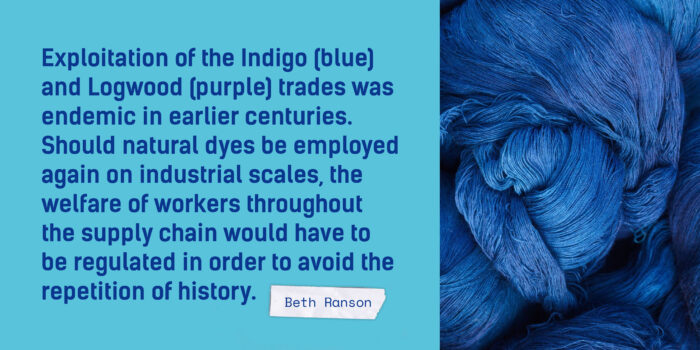The true cost of colour: The impact of textile dyes on water systems
Colour is a catalyst for sales success within the fashion industry; it is the first thing consumers notice about a garment. Before feeling the fabric, trying on for size, or considering the manufacturing processes, colour preference impacts the eye. According to Michael Braungart and William McDonough, on average, only 5% of the raw materials involved in the production and delivery processes is contained within a garment. It is therefore important that we also pay attention to the 95% of the material process that we do not see; a vast component of which is hidden water.
Thick, ink-like water flows through rivers surrounding garment factories; a toxic soup of chemicals discarded from the fashion industry’s synthetic dye processes, filtering into the water systems of the planet. Why is colour – this fundamental component of fashion production – allowed to pollute water systems throughout the world? As much as 200 tonnes of water are used per tonne of fabric in the textile industry. The majority of this water is returned to nature as toxic waste, containing residual dyes and hazardous chemicals. Wastewater disposal is seldom regulated, adhered to or policed, meaning big brands, and the factory owners themselves are left unaccountable. Examples of synthetic dyes are disperse, reactive, acid and azo dyes. Natural dyes, meaning colour obtained from naturally occurring sources – are another source of colour for textiles, but these are rarely employed on industrial scales.

Azo dyes are a commercially popular colourant for textiles. They are popular because they can be used at lower temperatures than Azo-free alternatives, and achieve more vivid depths of colour. But some are listed as carcinogens, and under certain conditions, the particles of these dyes can cleave (producing potentially dangerous substances known as aromatic amines). Upon contact with the skin, these can be harmful to humans and pollute water systems. Legislation exists in certain countries, including EU member states and China, that prohibits the sale of products containing dyes that can degrade under specific test conditions to form carcinogenic amines, but low traces of these amines have still been found in garments.
Natural dyes are a frequently suggested alternative, but like many brands guilty of ‘Greenwashing’ their processes, natural dyes on an industrial level give the impression of good behaviour, whilst introducing pollution problems of their own…
With production levels continuing to rise, and consumer demand for colour failing to diminish, alternatives to the current dyeing methods and regulations for water processing must be imposed.
HOW DOES THIS POLLUTION HAPPEN?
Much of the water used within production is utilised during the dyeing phase. Post-production water containing residual dye, mordants, chemicals, and micro-fibres is expelled into water streams untreated. This is frequently through pipes untraceable back to source, meaning factories can commit this offence anonymously. These hazardous chemicals do not break down as they enter rivers then oceans, making their way around the world.
In China, over 70% of the rivers are polluted (River Blue Documentary), meaning many of their 1.4 billion population cannot access uncontaminated water Ground water is contaminated, rendering wells unsafe for collecting water for domestic consumption. Billions of tonnes of wastewater are expelled from factories untreated, lowering dissolved oxygen within waterways to levels unable to sustain life. For the communities surrounding China’s Li River, and the factory workers handling these chemicals, exposure to toxic, potent and potentially deadly chemicals occurs on a daily basis.
WHO IS TO BLAME?
Western brands outsourcing the majority of their manufacturing are the main culprits, yet the impact of this devastating pollution is not experienced by the brands who perpetrate it. The rivers of high garment export countries are becoming unable to sustain life of any kind. Toxic to drink, an irritant when in contact with skin, and deadly to aquatic life, many of the rivers upon which communities rely are causing decreased life expectancies and increased health problems.

Professor Arjen Y. Hoekstra, creator of the water footprint concept explains the reality of the outsourcing of garment manufacturing to countries such as China and Bangladesh- two of the biggest exporters in the apparel industry:
“Many countries have significantly externalised their water footprint, importing water-intensive goods from elsewhere. This puts pressure on the water resources in the exporting regions”. In this way, the offenders continue to live with safe water and ever-expanding wardrobes, ignoring their far away trail of water devastation.
COULD NATURAL DYES BE A SOLLUTION ON AN INDUSTRIAL SCALE?
This debate is not a simple one.
Natural dyes are derived mostly from plants, seeds, fruits, barks, lichens and in some cases, insects. Though natural dyes have connotations of wholesome, toxin free textiles, this is not necessarily the case. Like synthetic dyes, they require a lot of water during production.
Though the dye materials themselves are not pollutants to water, the chemicals employed to fix the colour to the fibres are. These fixative chemicals are called mordants. Ground water and river pollution would occur if metallic compounds were used as mordants and not disposed of responsibly; the same problem synthetic dyes create.
SIDE NOTE ON CHEMICAL MORDANTS…
The term ‘mordant’, from the Latin term ‘mordere’, translates as ‘to bite’. This is a fitting name, as the objective of a mordant is to bond the dye with the fabric. Shades achieved with natural dyes are rarely as vivid as synthetic alternatives, and fade quicker from sunlight and wash cycles. Perspiration and PH levels of the skin can effect the colours achieved by natural dyes. The obvious remedy to this is the application of chemicals as mordants to fix the dyes and improve their longevity, vibrancy and resilience. But isn’t this defeating the object?
Whilst relatively harmless compounds can be used as mordants on domestic levels, such as sodium chloride (table salt), and diluted acetic acid (vinegar), when metallic salts are used things become more complicated.
Harmful and potentially lethal compound substances such as Potassium Dichromate (chrome), Stannous Chloride (tin), Copper Sulphate and Iron Sulphate are regularly used to achieve vivid shades with natural dyes.
Though the brilliance of these mordanted shades may be more commercial, these metallic substances effectively render the pollution free intention of natural dyes futile. It is possible to dispose of the chemically contaminated waste water safely, but this would require the same factory processing infrastructure that is currently lacking with synthetic dyes.
Without mordants, the colours achieved are more vulnerable to fading, potentially leading to shorter garment life. Indeed, these nuances in shade and the ever changing hues are arguably part of their beauty. The reality however is that whilst this is marketable where narrative engagement between consumer and textile lifecycles occurs, the fast fashion industry would unlikely engage with this.
Some natural dyes, known as Substantive Dyes, are high in tannins, which can adhere to fibres without the use of mordants. This is an area where small brands and start ups can utilise natural dyes, toxin free and enrich their designs with the narrative of sustainably produced colour. The history contained within natural dyes is an engaging consumer tool.
Many natural dyes are harvested from fragile environments, whilst agricultural land would also be necessary for production of industrial quantities of dye materials. Natural dye pigments only bond with natural fibres, meaning industries relying on petrochemical or regenerated yarns would not be able to use them. Best colour results are achieved on untreated protein fibres, with softer tones on cellulosic. Silk achieves vivid, sumptuous shades, but the silk industry is a point of animal welfare contention in itself. Therefore natural dyes create higher demands for raw materials, not just for the harvesting of dye sources, but for the processing of natural fibres. Treatments and finishes applied to natural yarns to improves fibre performance and extend garment life would also impact colour uptake.
Traceability in the supply chain of growing; harvesting and processing the raw materials present further issues. Indigo has a 5000 year history, from its beginnings as a dye stuff. Exploitation of the Indigo (blue) and Logwood (purple) trades was endemic in earlier centuries. Should natural dyes be employed again on industrial scales, the welfare of workers throughout the supply chain would have to be regulated in order to avoid the repetition of history. Sourcing from accredited suppliers and implementing strict regulations would be essential. As illustrated however, regulations across the fashion industry are inadequate and insufficient.
Important to consider too is the vast amount of land that would be required to grow enough natural dye stuffs to cater for the entire textile industry.

Natural dyes are therefore not a simple solution to the water pollution crisis but they do represent an important step. Different but equally important and challenging problems arise from their use.
WHAT DOES ALL THIS MEAN FOR THE FUTURE OF COLOURFUL FASHION?
The current textile dyeing systems are guilty of water pollution on a global scale. The waterways of our planet are ceasing to host life and endangering communities.
Factories claim costs of new infrastructure to process their water waste are too high, and with the fashion industry paying so little for their production to increase profit margins on their fast fashion, the factories are often unable to invest. Combined with this, a lack of education on the importance of the issue, and fundamentally a lack of care or compassion from the biggest brands contribute further to the crisis.
Putting pressure on brands for transparency in supply chains, and adjusting our expectations as consumers to purchase less and reject endorsement of fast fashion are ways we can individually make an impact. Green Peace’s Detox campaign has gone a long way in pressuring brands to reduce and remove chemicals from their water processes, but Greenwashing is still prevalent amongst many retailers; more must be done. Looking past colourful aesthetics to the morality behind the creation of our clothes will facilitate positive change.
***
Beth Ranson is a practice-based knitted textile designer and researcher in biodegradable fibres. Motivated by problem solving in circular, sustainable design contexts, Beth occupies the space between design and sustainability theory: and it’s an interesting space to be. As a specialist in the use of natural dyes, Beth researches the beauty held in their narrative, as well as their potential negative impacts on the environment.







